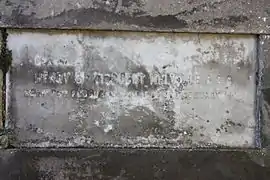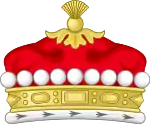Henry Dundas, 3rd Viscount Melville
General Henry Dundas, 3rd Viscount Melville GCB (25 February 1801 – 1 February 1876)[1] was a senior British Army officer and peer.
Henry Dundas, 3rd Viscount Melville | |
|---|---|
 Henry Dundas, 3rd Viscount Melville | |
| Born | 25 February 1801 |
| Died | 1 February 1876 (aged 74) |
| Allegiance | |
| Service/ | |
| Rank | General |
| Commands held | Commander-in-Chief, Scotland |
| Battles/wars | Canadian rebellion |
| Awards | Knight Grand Cross of the Order of the Bath |

Military career
The eldest son of Robert Dundas, 2nd Viscount Melville, and his wife Anne, Dundas joined the Army as a lieutenant in the 3rd (or Scots) Guards in 1819.[2] He was promoted to captain of the 83rd Regiment in 1824, major in 1826 and lieutenant-colonel in 1829. In 1837 he was active in suppressing the Canadian rebellion, after which he was appointed colonel and aide-de-camp to Queen Victoria in 1841.[2]
He played a distinguished part in India as a brigadier-general in 1848–49, chosen to command the column sent from Bombay to co-operate with Lord Gough's army in the Second Anglo-Sikh War. He was second in command at the capture of Multan and then joined the main army with his force for the battle of Gujrat.[2]
He returned to England in 1850 and became 3rd Viscount Melville on his father's death in 1851. He became Commander-in-Chief, Scotland in 1854[3] remaining in that post until 1860, in which year he was made Governor of Edinburgh Castle.[2] He was raised to the rank of general in 1868.[2]
He died unmarried at Melville Castle, near Edinburgh in 1876. He is buried in the simple Dundas Vault in Old Lasswade Kirkyard, together with his ancestors and descendants.
His younger brother, Richard Saunders Dundas, was a prominent naval officer.
He was succeeded as Viscount Melville by his brother Robert.
Parliament
He was a Member of Parliament (MP) for Rochester from 1826 to 1830,[4] and for Winchelsea from 1830 to 1831.[5]
Arms
  |
|
References
- Leigh Rayment's Peerage Pages – Peerages beginning with "M" (part 3)
- "Henry Dundas, 3rd Viscount Melville". Oxford Dictionary of National Biography. Retrieved 29 November 2014.
- "The new army list and militia list January 1855". Retrieved 1 December 2014.
- Leigh Rayment's Historical List of MPs – Constituencies beginning with "R"
- Leigh Rayment's Historical List of MPs – Constituencies beginning with "W" (part 4)
- Burke's Peerage. 1878.
 This article incorporates text from a publication now in the public domain: "Dundas, Henry (1801–1876)". Dictionary of National Biography. London: Smith, Elder & Co. 1885–1900.
This article incorporates text from a publication now in the public domain: "Dundas, Henry (1801–1876)". Dictionary of National Biography. London: Smith, Elder & Co. 1885–1900.
External links
- Hansard 1803–2005: contributions in Parliament by the Viscount Melville
| Parliament of the United Kingdom | ||
|---|---|---|
| Preceded by Lord Binning Ralph Bernal |
Member of Parliament for Rochester 1826–1830 With: Ralph Bernal |
Succeeded by Lord Villiers Ralph Bernal |
| Preceded by Viscount Howick John Williams |
Member of Parliament for Winchelsea 1830–1831 With: John Williams |
Succeeded by Stephen Lushington John Williams |
| Military offices | ||
| Preceded by Sir Thomas Napier |
Commander-in-Chief, Scotland 1854–1860 |
Succeeded by Sir Duncan Cameron |
| Governor of Edinburgh Castle 1855–1876 |
Vacant Title next held by Sir Archibald Cameron | |
| Preceded by Sir John Eardley Inglis |
Colonel of the 32nd (The Cornwall) Regiment of Foot (Light Infantry) 1862–1863 |
Succeeded by Sir George Brown |
| Preceded by Joseph Paterson |
Colonel of the 60th Regiment of Foot 1863–1876 |
Succeeded by Sir Arthur Cunynghame |
| Peerage of the United Kingdom | ||
| Preceded by Robert Dundas |
Viscount Melville 1851–1876 |
Succeeded by Robert Dundas |